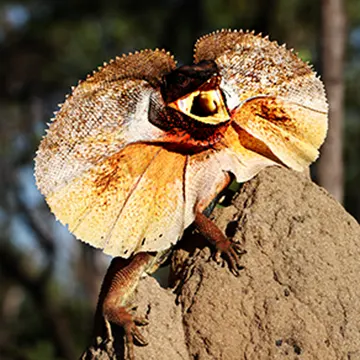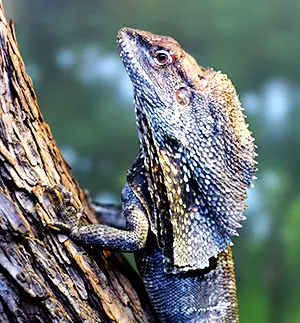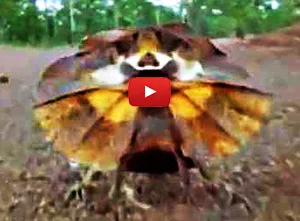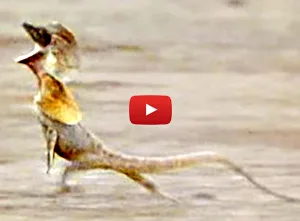Frilled Neck Lizard (Frilled Dragon)

Photo: Frilled Lizard with frill in defence pose.
Contents
What is a Frilled Lizard?
The frilled lizard, also known as the Frilled Dragon and Frill-neck Lizard, is tree-dwelling lizard that lives in northern Australia and southern New Guinea. Its most noticeable characteristic is a large colourful ruff which it opens to scare off predators. Despite its fearsome appearance, the frilled dragon is harmless to humans.
The frilled lizard's scientific name is Chlamydosaurus kingii. Because of the odd way it runs, it is sometimes jokingly referred to as the Bicycle Lizard.
Frilled Lizard - Description

Photo: Frilled Lizard on a tree with frill folded
General Description
The frilled lizard is approximately one meter in length and weighs around half a kilogram. Its tail is almost two-thirds of its body length. The frilled lizard usually camouflages itself by blending in with its environment. For example, lizards living in dry, desert environments will usually have orange, red, and brown tones. Those found in more tropical areas will tend to be in shades of grey or brown. It has a large mouth with small, sharp teeth along its jaws and two front and bottom canine teeth with which to grab its prey.
Frilled Lizard's Frill
The most noticeable characteristic of this lizard is its frill around its head. Usually, this ruff is folded back against its body like a cape. But when frightened, the lizard opens its mouth out wide to scare off predators. The large frill is supported by long spines made of cartilage, which are attached to its jawbone. When the lizard opens its mouth wide, it pushes these spines back, forcing the ruff to open out like an umbrella. When fully extended, the frill can reach a diameter of up to 30cm.
Purpose of the Frill
The frilled lizard's frilled ruff's primary purpose seems to be a scaring mechanism. However, it may also use its frill as a radiator to help the lizard regulate its body temperature. Being cold-blooded, spreading open its ruff in the early morning sunlight helps the lizard quickly warm its body.
Frilled Lizard - Running & Attack Videos
When frightened, the frilled lizard will open its yellow and pink coloured mouth wide, fully extend its large frill to look intimidating, and run on its hind legs towards its attacker, hissing loudly and trying to intimidate them. If this display of bravado doesn't scare its attacker away, it usually turns tail and runs away at great speed. Because of the way it runs, it is sometimes jokingly referred to as the Bicycle Lizard.
Although it may appear intimidating, this lizard is entirely harmless to humans. It will run away rather than attack. But it can bite if provoked. Its bite is painful but harmless.

Photo: Frilled lizard habitat map
Frilled Lizard - Habitat Where Do the Frilled Lizards Live?
Frilled lizards are tree-dwelling lizards that live in the warm temperate forests of northern Australia. They descend to the ground occasionally to move from tree to tree or to feed.
Frilled Lizard - Diet What do Frilled Lizards Eat?

Photo: Frilled Lizard with a grasshopper on its head
Frilled lizards are carnivorous. They eat insects, spiders, beetles, termites, cicadas and ants. They also prey on smaller lizards and mammals.
Frilled lizards hunt by lying in wait for prey to pass close by and then pounce on their victims.
Frilled Lizard - Reproduction & Life Cycle Frilled Lizard Babies
Frilled lizards breed around September and October. The female lays between 8 to 26 soft-shelled eggs in a nest 5-20 centimetres below ground in a sunny location. She then abandons the nest. The eggs incubate for about two and a half months. The temperature of their nest partially determines the gender of the baby lizards. If the temperature of the nest is too hot or too cold, then the brood will be exclusively female. On the other hand, if the nest is within normal incubation temperatures, then there will be equal numbers of male and female baby lizards.
Baby lizards hatch as fully functional little lizards and live independently from the moment they hatch.
The frilled lizard's life span is up to 20 years.
Frilled Lizard - Threats and Predators Is the Frilled Lizard Surviving?
The major threats to the Frilled Lizard are eagles, owls, larger lizards, snakes, dingoes, and quolls. More recently, they have also fallen prey to feral cats.
Frilled Lizard – Conservation Status Is the Frilled Lizard Endangered?
Frilled Lizards are not considered threatened or endangered. They can be kept as pets.
25 Frilled Neck Lizard Facts
- The Frilled lizard is also known as the Frill-necked lizard and Frilled Dragon.
- It grows to approximately a meter in length and weighs around half a kilogram.
- Its most striking feature is the ruff of skin it holds against the back of its neck like a folded umbrella.
- When startled or threatened, it has a unique trick to scare its opponents.
- It stands on its hind legs and opens its yellow and orange mouth wide.
- And springs open its ruff, like an open umbrella, to frighten its opponent.
- Hissing loudly, it may also run on its hind legs towards its attacker.
- If this display doesn't scare off its attacker, it will turn tail and run away.
- Although it may appear intimidating, this lizard is entirely harmless.
- It will run away rather than attack a human.
- Because of the way it runs, it is sometimes referred to as the Bicycle Lizard.
- Being cold-blooded, it also opens its frill to the early morning sunlight to warm its body quicker.
- The frilled lizard is an arboreal tree-dwelling animal. It only comes to the ground to move from tree to tree.
- It inhabits the warm-temperate forests of northern Australia.
- Lizards living in desert environments tend to be orange, red, and brown.
- Those in more tropical areas will tend to come in shades of grey or brown.
- The lizard's large frill is supported by long spines attached to its jawbone.
- When it opens its mouth wide, these spines are pushed back, forcing the ruff to spread.
- The frilled lizard is a lay in wait predator. It waits for prey to come within reach and then pounces on them.
- It feeds on insects such as spiders, beetles, termites, cicadas and ants.
- It also eats smaller lizards and animals.
- The female lays 8-26 soft-shelled eggs in a nest below ground in a sunny location.
- If the nest temperature is too hot or too cold, the young lizards will all be female.
- When the temperature is within the ideal range, the babies will be male and female.
- Frilled lizards can live up to 20 years.
All Rights Reserved. (Last Updated: May 30, 2025)

